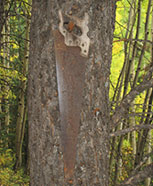May 13, 1993 / Vol.31 No.21

Telluride's summer festival season begins Memorial Day weekend, May 28-31, when the curtain rolls up on the 15th annual Telluride MountainFilm Festival. MountainFilm is the first festival in the United States devoted entirely to the cinema of mountain sports, mountaineering, adventure and the environment.
A film certain to compete for honors this year is Ken Bailey and Miranda Smith's film Wilderness: The Last Stand, which examines the mandate and performance of the U.S. Forest Service.
The National Forest System was created in 1905 to manage the remainder of the pristine forests that once covered North America. Bailey and Smith's film takes a scathing look at the timber cutting mindset that dominates the U.S. Forest Service. The film concentrates on the timber policies of the Bitterroot National Forest in Montana, but in no means is the problem unique to Montana...
The deforestation of the Amazon rain forests has become a cause celebre in the environmental movement, but Smith says she wanted to make a film that draws attention to the massive clear-cutting that is happening in our own country. And most importantly, Smith says she wanted to make a piece that would encourage people to act.
"Hopefully, with this film, people will want to get involved," Smith said. "We didn't answer all the problems in this film, that's for sure. Hopefully, we raised some of the issues, and it will make people wonder what is going on. In this situation, it's our public lands that are being deforested, and we have a great opportunity to let our voices be heard, and be part of the process of maintaining these forests."
The film takes a delicate and ultimately sympathetic look at loggers whose livelihood depends upon the cutting of timber. The loggers are not vilified at all. Smith and Bailey affirm that there is not much difference between loggers and environmentalists. One of the most powerful scenes in the film is a sequence in which editor David Zeiff cuts rapidly between a pro loggers rally and an anti-tree cutting rally. The issues are complex, and Smith and Bailey respect the players who are often merely pawns in the game.
Wilderness: The Last Stand is not a witch hunt either. Smith and Bailey's coverage of the Forest Service is remarkably balanced.
"The Forest Service has many good people," Bailey said. "It's just that the scientists and biologists haven't been heard. It's been a timber management policy to go out and clearcut. That's been their incentive. It's not any one person's fault. It's just the way that the Forest Service is set up that is the problem."
What helps the film float are the engaging stories that are told within Wilderness: The Last Stand. There is a powerful piece on former Forest Service Supervisor John Mumma who, when he refused to cut down enough forest, was given the choice by his superiors to either retire or be transferred to a desk job. Another important player in the film is Jeff Debonis, who worked with the Forest Service for 12 years before retiring in protest of the Forest Service's timber policies.
But ultimately, the forests themselves, shot beautifully by Bailey, are at the center of the film.
"Our remaining forests are a treasure," Smith said. "It's time we start treating them that way."
Geoff Hanson

